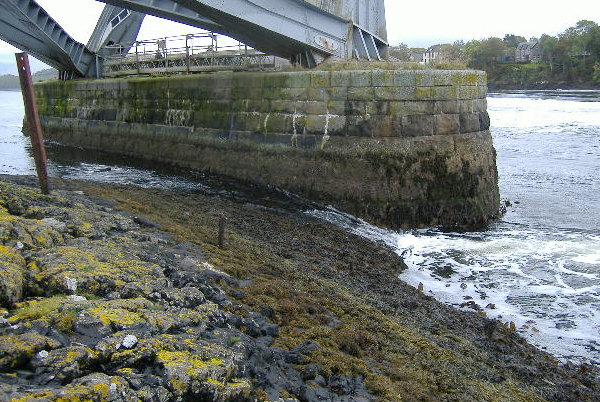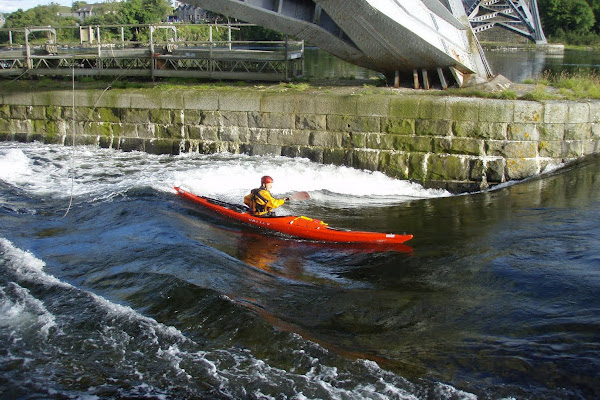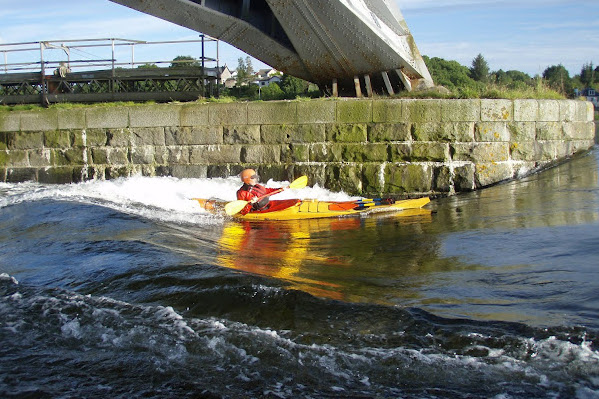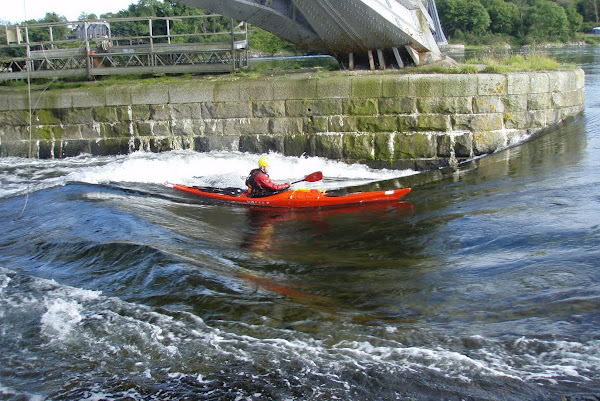The north pier in a flood tide
I think the north pier provides more interest than the south pier. First of all, to give you a sense of the geology - here is the west end of the north pier, when the tide at Connel is down to 0.6 metres, and Loch Etive is nearly a metre higher.

When it is high tide at Connel, with a high tide of 4 metres - which is a good Spring tide height - the sea is up to the third stone from the top of the pier, and the steel post just on the left edge of the picture is getting its feet wet. You can imagine the impact that ramp of rock is going to have on a full flow flood tide.
The result is something like this - and thanks to Myles and Fraser from Helensburgh for the photos.



It`s a fine looking green wave, sometimes followed by a wave train right down the full length of the pier. On this occasion the tide height was round about 4.1 metres.
However it isn`t always just as good for surfing as you might expect, or even as it looks in these pictures. On this particular evening, there was a strong diagonal current, which made staying on the wave quite a fight.
One problem is that the ramp running down to the trough of the wave has a lot of boils in it, which push the bow off to one side.
Also, the quality of the wave varies considerably with different heights of Spring tides.
One of the things that I`ve become increasingly aware of is that there can be a significant difference between the tide height predicted by tide tables, and the actual tide height achieved.
During the late spring of 2011 there was a predicted tide height of 3.5 metres, which actually reached almost to the top of the small post in the picture above - and a predicted tide height of 3.7 metres which only got up to the bottom of the small post.
I have had some beautiful surfing on a predicted wave height of 3.5 metres - I have had predicted tide heights of 3.7 metres where the wave just never got going - I have had 3 evenings in a row where the predicted tide height of 3.7 metres produced a wave that was like surfing on silk it was so smooth - so it is a bit of gamble using tide tables.
To add to the gamble, the atmospheric pressure also affects the tide height - if the UK is under a high pressure, the tide heights are lower than predicted, and if the UK is under a low pressure, the tide heights are higher than the predicted height. This effect on tide height is mathematically predictable - a change of pressure of 1 millibar will change the tide height by 1 centimetre. Tide tables are calculated with an assumed atmospheric pressure of 1013 millibars, and deviations of up to +40 cms or -20 cms are quite common. Larger deviations are possible.
As a rough guide, using the tide height figures for Oban in either printed tide tables or web based information to plan a visit to this wave, here are some pointers as to what heights to look for -
- 3.5 - 3.6 metres - a bit of a gamble as to whether you would get any surfing - you might get lucky, you might not
- 3.7 - 3.9 metres - a good probability that you would get some good easy going surfing
- above 4.0 metres - getting faster, the surfing is getting harder - if the previous low tide is down below 0.6 metres or so, you may have to wait until about 20 - 30 minutes before high tide for the current to slow down enough to form a decent wave
Although the formation of the wave itself is fairly reliable, the surfability of the wave is much more variable - there are many factors which affect it - some of them are
- the height of the previous low tide
- the depth of water between the pier and the shore
- the difference in height between the tide level west of the bridge and the level of the loch
- the speed of the water
- the wind - an east wind is generally not much of a problem, but with a west or south west wind, the chop in the bay comes right down the ramp, through the wave, and out into the eddy under the bridge - it can also affect the eddy line, which you need to get up on to the wave
The high speed of the water when there is a large tidal range has quite a few effects -
- the water speed can be higher than the surfing speed of the boat - you get washed off backwards
- there may be a long and severe wave train which stretches way beyond the end of the pier - I`ve counted 11 waves in one wave train - it looks quite scary, but can be associated with good surfing on the first wave
- the eddyline between the rapid and the eddy can get quite hard, and difficult to cross - this hard eddy line can extend beyond the end of the pier - this can be quite a problem if you have been washed backwards off the wave and are trying to get back into the eddy
- the boils coming down the ramp become quite major, and push the bow hard round and you are off the wave
Because of the slope of the rocks, as the water level gets higher, the channel gets wider as well as deeper, and the speed of the water gets higher as well - on high Spring tides there is one heck of a lot of water flowing through the channel, and it becomes a fairly major rapid.
I am not sure if this wave is ever steep enough for a playboat - you sometimes get a small pile, but only over on the river right side, close to the pier. Older styles of longer river running/play boats may get some fun.
The type of sea kayak makes a difference to how well you get on - manouverable boats are a definite benefit, as you spend quite a lot of time turning round and manouvering into position. The Anas Acuta works well, as do shorter sea kayaks like the Romany and the Avocet. Full length touring sea kayaks should catch the wave, but do require a lot more effort.
There is a bit of an advantage in this channel during the flood tide - the north side of the tidal flow through the main narrows is not straight through the narrows, but heads diagonally river left, as the water squeezes through the gap between the north pier, and the north end of the reef. Because of the north pier, it forms a huge eddy on the north side of this flow, which extends quite far towards the moored yaughts. The water flowing through the channel to the north of the pier joins into the head of this eddy, so if you come to grief in the channel, you may get washed round to the river left, towards the shore and into still water, rather than heading up into the further regions of Loch Etive.
I would be a little wary of using a smart new composite boat on this wave - there is a risk of getting pushed to the right and graunching on the rocks, or getting pushed violently to the left and hitting the pier as you get washed down the rapid. I recommend taping some padding round the first 10 cms or so of the bow, and adding some tape to the first metre or so of the keel line.
Finally for this section - if you are coming down between the north pier and the shore to get to this wave, be careful about how you do it. Above the wave, there is a strong diagonal current away from the shore towards and around the far side of the north pier. The safest way to negotiate this is to stay close to the shore. If you let the current wash you out towards the pier, there is a risk that the boat will broach onto the end of the pier and get pinned. A composite boat will probably break and bend round the pier with very sharp points and edges which will cut into you. A plastic boat pinned like this will slowly fold and wrap itself around the pier. If you are still in it, you are going to end up trapped in it as the deck collapses. Either way, there is a significant risk of injury or death. If you are pinned, don`t hang around, get out of the boat as quickly as possible.